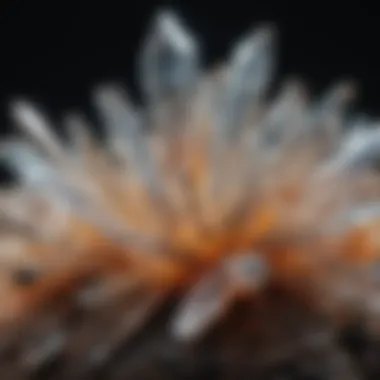A Comprehensive Guide to Choosing the Best Microscope for Hobbyists


Rock and Fossil Identification
In the captivating realm of microscopy for hobbyists, the exploration of rocks and fossils unveils an intriguing world waiting for discovery. Delving into types of rocks and fossils opens a gateway to a diverse array of specimens, ranging from sedimentary to igneous to metamorphic varieties. Each comes with unique characteristics that enthusiasts can observe under the lens, from intricate mineral compositions to distinctive textures. To aid in identification, specialized tools such as magnifying lenses, polarizing filters, and hand lenses become indispensable companions, enabling hobbyists to scrutinize fine details and unveil the hidden beauty within these geological marvels.
Collecting Tips and Techniques
When it comes to collecting rocks and fossils, adhering to best practices ensures a fruitful and enriching experience for hobbyists. By understanding the importance of geological context, enthusiast can seek out prime collecting sites where valuable specimens abound. Safely extracting these treasures requires delicate handling and the use of appropriate tools like chisels, hammers, and brushes to avoid damage. Utilizing techniques such as mapping rock layers or fossil deposits enhances the likelihood of successful finds, providing enthusiasts with a treasure trove of geological wonders to explore and analyze.
Preservation and Display
Preservation techniques play a crucial role in maintaining the integrity of collected rocks and fossils, prolonging their beauty and scientific value. From gentle cleaning methods to stabilizing fragile specimens, preserving these geological treasures ensures their longevity and continued study. Proper storage practices, such as using acid-free paper, archival boxes, or display cases, safeguard against deterioration and environmental influences. Creative display ideas further enhance the aesthetic appeal of collections, allowing hobbyists to showcase their finds in visually engaging and educational ways that captivate both experienced enthusiasts and curious onlookers.
Geological Insights
Unveiling the geological past through the study of rocks and fossils provides profound insights into Earth's history and the processes that have shaped its landscape over millennia. Geological formations offer a window into the Earth's dynamic forces, showcasing the immense power of tectonic activity, erosion, and geological upheavals. The historical significance of rocks and fossils extends beyond their age, revealing clues about past ecosystems, climate conditions, and evolutionary processes. Examining notable discoveries in the field offers a glimpse into groundbreaking findings that have reshaped scientific understanding, highlighting the endless possibilities for exploration and discovery in the intricate world of geology.
Understanding Microscopes for Hobbyists
The world of microscopy opens up a realm of intricate details and hidden wonders, making it a fascinating domain for hobbyists to explore. Understanding Microscopes for Hobbyists is a crucial foundation for enthusiasts looking to embark on this journey of discovery. By grasping the fundamental concepts behind microscopes, hobbyists can elevate their exploration to a more informed and immersive level. This segment of the article serves as a springboard, introducing readers to the key aspects they need to consider when delving into the realm of microscopy as hobbyists.
Importance of Choosing the Right Microscope
Selecting the right microscope is the cornerstone of a fulfilling microscopy experience for hobbyists. The microscope chosen can make a significant difference in the quality of observations and the overall enjoyment of the hobby. Factors such as magnification capabilities, image clarity, and ease of use all hinge on picking the appropriate microscope for one's needs. A well-suited microscope not only enhances the viewing experience but also unlocks the full potential for detailed exploration and study within the chosen field of interest.
Factors to Consider Before Purchasing


Quality of Optics
The quality of optics in a microscope plays a pivotal role in determining the clarity and precision of images observed. High-quality optics contribute to sharper images, better resolution, and reduced distortions, allowing hobbyists to delve into the minute details of their specimens with unparalleled clarity. When choosing a microscope, optics quality should take precedence as it directly impacts the overall viewing experience and the accuracy of observations.
Illumination Options
Illumination is a critical feature of microscopes that significantly influences the visibility and contrast of specimens. Different illumination options, such as LED or halogen lighting, offer varying levels of brightness and color accuracy, catering to different viewing needs. The choice of illumination should align with the type of specimens being observed and the desired image clarity, ensuring optimal lighting conditions for detailed exploration.
Magnification Range
The magnification range of a microscope dictates the level of detail that can be observed in a specimen. Selecting a microscope with a versatile magnification range allows hobbyists to zoom in and out to observe various structures and textures with precision. Finding a microscope that offers a balance between low and high magnification capabilities is essential for accommodating different specimen sizes and types, enabling a comprehensive exploration experience.
Durability and Build Quality
Durability and build quality are paramount considerations when investing in a microscope for long-term use. A sturdy construction ensures the reliability and longevity of the instrument, safeguarding it against wear and tear from regular usage. Opting for a microscope with durable materials and robust design not only enhances its lifespan but also sustains consistent performance, promoting uninterrupted exploration and study for hobbyists.
Portability and Size
The portability and size of a microscope should align with the intended usage and storage space available to hobbyists. Compact and lightweight microscopes offer convenient mobility and storage flexibility, making them suitable for enthusiasts who engage in fieldwork or have limited workspace. Choosing a microscope that balances portability with functionality ensures ease of transport and setup without compromising on optical quality or performance.
Types of Microscopes Suitable for Hobbyists
Compound Microscopes
Compound microscopes are versatile instruments that utilize multiple lenses to achieve high magnification levels, making them ideal for viewing transparent and thinly sliced specimens. Their impressive magnification range and resolution capabilities enable hobbyists to explore intricate details within a specimen's structure with exceptional clarity. Compound microscopes are fundamental tools for in-depth microscopic study and analysis, making them indispensable for hobbyists pursuing detailed observations.
Stereo Microscopes


Stereo microscopes, also known as dissecting microscopes, provide a three-dimensional view of specimens, allowing hobbyists to observe objects with depth perception and spatial awareness. These microscopes are suitable for examining larger, solid specimens that require a broader field of view and magnification. Stereo microscopes offer enhanced visibility and manipulation capabilities, making them essential instruments for precise dissections, intricate manipulations, and detailed examinations in various hobbies and fields of interest.
Digital Microscopes
Digital microscopes integrate digital imaging technology to capture and display images on a monitor or computer screen, offering a convenient and versatile viewing experience for hobbyists. They enable real-time viewing, image recording, and sharing of observations, enhancing collaborative learning and documentation. Digital microscopes cater to modern technological needs, facilitating advanced imaging features and analysis tools that augment the exploration process for hobbyists seeking interactive and digital microscopy experiences.
USB Microscopes
USB microscopes are compact devices that connect directly to a computer, transforming the screen into a viewing platform for magnified observations. These portable microscopes offer flexibility and accessibility, enabling hobbyists to explore specimens directly on their screens without the need for additional eyepieces. USB microscopes are ideal for on-the-go observations, digital documentation, and interactive sharing, making them valuable tools for hobbyists engaging in remote microscopy or digital imaging activities.
Pocket Microscopes
Pocket microscopes are handheld, lightweight devices that provide magnification on the go, allowing hobbyists to inspect specimens in various environments. Their compact size and portability make them ideal for quick examinations, fieldwork, or outdoor activities where traditional microscopes may not be feasible. Pocket microscopes offer versatility and convenience for enthusiasts seeking portable and user-friendly magnification tools that can accompany them on their exploratory adventures.
Top Recommendations for Hobbyist Microscopes
In this section, we delve into the crux of selecting the best microscopes for hobbyists. Choosing the right microscope is crucial for enthusiasts as it directly impacts the quality of their observations and experiments. The top recommendations listed here have been carefully curated to cater to the diverse needs of hobbyists, considering factors such as magnification capabilities, optical quality, durability, and user-friendliness.
1. Best Compound Microscope for Hobbyists
When it comes to compound microscopes, hobbyists need a reliable and versatile tool that offers high magnification for viewing minute details. The best compound microscope for hobbyists should feature top-notch optical components to ensure clear and sharp images. Additionally, factors like illumination options, adjustable magnification range, and sturdy construction play a significant role in enhancing the overall microscopy experience for enthusiasts.
2. Top Stereo Microscope Picks
Stereo microscopes are essential for hobbyists who need three-dimensional viewing capabilities. These microscopes offer a wider field of view and lower magnification compared to compound microscopes, making them ideal for examining larger specimens with depth. The top stereo microscope picks on our list excel in ergonomics, magnification versatility, and image clarity, providing hobbyists with a comprehensive tool for various microscopy tasks.
3. Recommended Digital Microscopes


Digital microscopes have revolutionized microscopy by incorporating digital imaging technology, allowing hobbyists to capture, store, and share their observations effortlessly. The recommended digital microscopes for hobbyists boast high-resolution cameras, easy-to-use software interfaces, and compatibility with different devices for convenient data transfer. These microscopes bridge the gap between traditional microscopy and modern digital advancements, offering hobbyists a seamless exploration experience.
4. USB Microscopes for Hobbyist Exploration
USB microscopes offer portability and convenience to hobbyists who prefer compact microscope solutions. These microscopes are plug-and-play devices that can connect directly to a computer or mobile device for real-time imaging and analysis. The USB microscopes featured in this guide come with adjustable LED lighting, on-device controls, and software enhancements for a user-friendly microscopic journey. They are ideal for hobbyists looking to explore microscopic worlds on the go.
5. Portable Pocket Microscopes to Consider
For hobbyists who prioritize mobility and ease of use, portable pocket microscopes are the perfect choice. These compact microscopes can fit in your pocket or bag, allowing you to carry them anywhere for impromptu microscopy sessions. Despite their small size, these pocket microscopes deliver impressive magnification power, image quality, and durability, making them indispensable tools for outdoor explorations and field studies.
Additional Considerations and Tips
Maintenance and Care of Your Microscope
Proper maintenance and care of your microscope are foundational aspects that ensure its longevity and optimal performance. Cleaning lenses regularly, storing the microscope in a dust-free environment, and inspecting for any damages are simple yet vital practices. Maintaining appropriate lighting conditions and avoiding exposure to extreme temperatures also play a role in preserving the microscope's quality. By incorporating routine checks and gentle cleaning methods, hobbyists can prolong the lifespan of their microscopes and maintain clear imaging results.
Enhancing Your Microscopy Experience
Accessories and Add-Ons
Accessories and add-ons are essential elements that contribute significantly to the overall microscopy experience. Whether utilizing specialized eyepieces, filters, or mechanical stages, these additions enhance functionality and expand the capabilities of the microscope. The key characteristic of accessories lies in their ability to customize microscopy setups according to specific needs, allowing hobbyists to explore various imaging techniques and specimen manipulations with precision. While benefits include increased versatility and enhanced imaging quality, users should carefully select accessories compatible with their microscope model to maximize performance.
Sample Preparation Techniques
Sample preparation techniques are pivotal in achieving optimal results during microscopic observations. From slide preparation to staining methods, each technique plays a crucial role in enhancing specimen visibility and highlighting specific structures. The key characteristic of these techniques is their ability to transform raw samples into detailed specimens ready for examination. While benefiting hobbyists with improved clarity and contrast in imaging, certain techniques may require practice and expertise for effective implementation.
Exploring Different Specimens
Exploring a diverse range of specimens is a stimulating aspect of microscopy that broadens horizons and offers unique insights into the microscopic world. Whether examining plant cells, microorganisms, or mineral samples, each specimen provides a distinct perspective on biology, geology, or materials science. The key characteristic of exploring different specimens is the educational value and discovery opportunities they offer to hobbyists. While advantages include fostering curiosity and expanding knowledge, varying specimen properties may pose challenges in imaging and analysis, requiring adaptability in microscopy techniques.
Resources for Further Learning
Access to supplemental resources is crucial for hobbyists looking to deepen their understanding of microscopy and explore advanced topics. Online forums, scientific journals, and microscopy workshops are valuable sources that provide in-depth information on specialized techniques, emerging trends, and community insights. Engaging with these resources not only supports continuous learning but also connects enthusiasts with like-minded individuals passionate about microscopy. By tapping into these avenues, hobbyists can expand their knowledge base, refine their skills, and stay abreast of developments in the field.


Unveiling the Fascination of a 2-Inch Megalodon Tooth: A Journey into Paleontology's Enigmatic Realm





